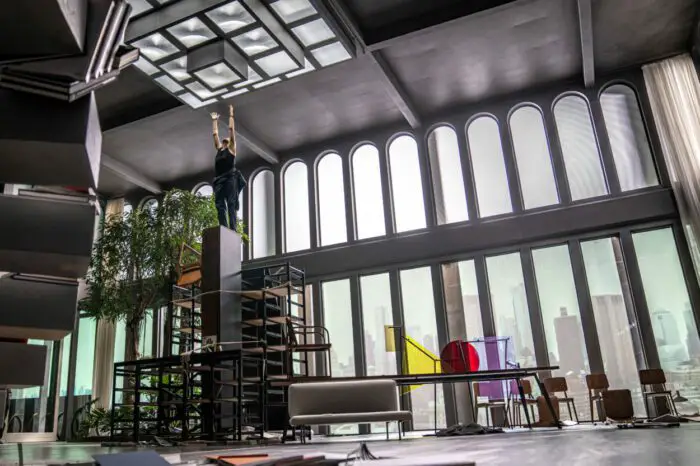Inside has a premise we’re all too familiar with: a person is trapped alone inside an apartment for an indeterminate amount of time. Sounds like March of 2020. The wrinkle in Inside is that this person is Nemo (Willem Dafoe) and he’s an art thief who broke into a rich person’s apartment to steal priceless works of art. The heist goes south and Nemo finds himself trapped in the confines of this apartment with no company except the works of art and a dying pigeon.
The film wastes no time in setting up this premise and trapping Nemo inside the apartment. Within the first ten minutes the doors are locked and the alarm is blaring nonstop. After that, it’s just Nemo, suddenly tasked with survival instead of high-end theft. The claustrophobic feeling doesn’t come immediately, the same way it felt back in the early stages of the Covid lockdown. At first, it’s kind of fun to look at the art adorning the walls and the high-tech appliances. It’s only after a while that reality sinks in and the once-sprawling penthouse feels more like a cardboard box.

Inside is a modern Cast Away, a take on the survival genre that surely must have come to fruition after the collective experience of lockdown. Nemo is luckier than Tom Hanks’ character in Cast Away in that he has shelter and a small amount of food, but Nemo’s at the mercy of technology. Much of the penthouse is controlled by “smart” appliances. The thermostat goes haywire, cranking the temperature to 90 degrees, and the refrigerator plays “Macarena” if the door is kept open for too long. What starts as a humorous quirk of the fridge turns into something deeply melancholic. The water and gas are inexplicably shut off, leaving Nemo to fend for himself. Hanks had Wilson the volleyball, Nemo a pigeon. Neither provides any real assistance in helping their human counterpart escape, but they provide essential companionship.
Nemo’s proximity to the outside world strangely makes the situation feel much more dire than if he were on a deserted island. When truly stranded on a patch of land with nothing else in sight, there’s not always a lot of hope. It seems like a one-in-a-million shot that somebody will stumble upon the island. Inside is different. Nemo is tantalizingly close to people who can solve this predicament for him. He has access to the security cameras and sees other residents moving about the building. There’s an entire city of people outside the massive floor-to-ceiling windows, but he has no means of reaching them. The penthouse is secluded, with thick doors and windows. It was built for privacy and Nemo is increasingly desperate for someone to notice him.

Inside is a (mostly) one-man show. There’s Jasmine (Eliza Stuyck), a cleaner, but she’s only seen through security cam footage. Nemo talks with someone over his walkie talkie during the heist code-named Number 3 (Andrew Blumenthal), but he’s only a crackling voice who disappears when the theft goes south. For all intents and purposes, Inside is Dafoe’s show. He deftly carries this sparse plot with very little dialogue. There are few actors working today who could carry a film like this, and fortunately Dafoe is one of them.
Inside is a story of survival, and of one man slowly losing his sanity. Not unlike his performance in The Lighthouse, Dafoe is able to make the slow transition believable for the audience. We get to see his cunning, intuitive nature and how the isolation steadily wears those attributes away. Nemo is fairly methodical and quiet at the beginning of the film, focusing on escape. As time passes, he begins to talk back to the security cameras and give names and backstories to the people he sees. He even gives a stand-up comedy performance for an audience of no one.
As compelling as Dafoe is, Inside hits a plateau toward the middle of the runtime. Within the walls of this penthouse are conversations about what constitutes art, how destruction and creation are intrinsically tied to one another, the stakes of survival, and the human need for interaction. However, these themes, except for the survival stakes, are largely ignored until the film’s final act. That’s when the director’s intended takeaway is literally scrawled on a wall by Nemo. The film also takes a moderate suspension of disbelief that no one would check on this apartment in time the owner was away. There are fish that absolutely need to be fed that ultimately get eaten by Nemo.
In the opening and closing narrations, Nemo muses that “art is for keeps.” Inside questions whether art, and only art, can sustain us. Ultimately, the answer to that question lies in the heart of the audience and will vary from person to person. The answer, though, is probably the same for the audience after the film ends as it was before the film began. Like the penthouse, Inside is a lavishly decorated, but ultimately sparse, reflection on art.



